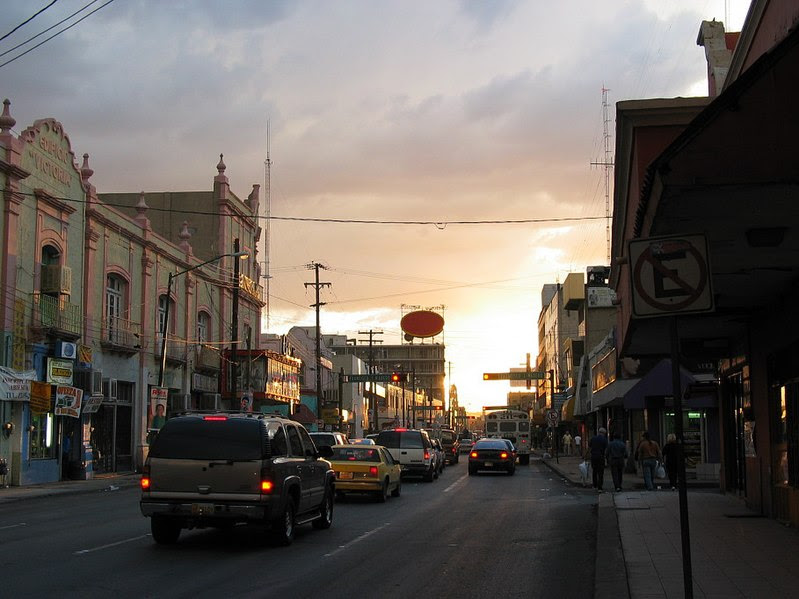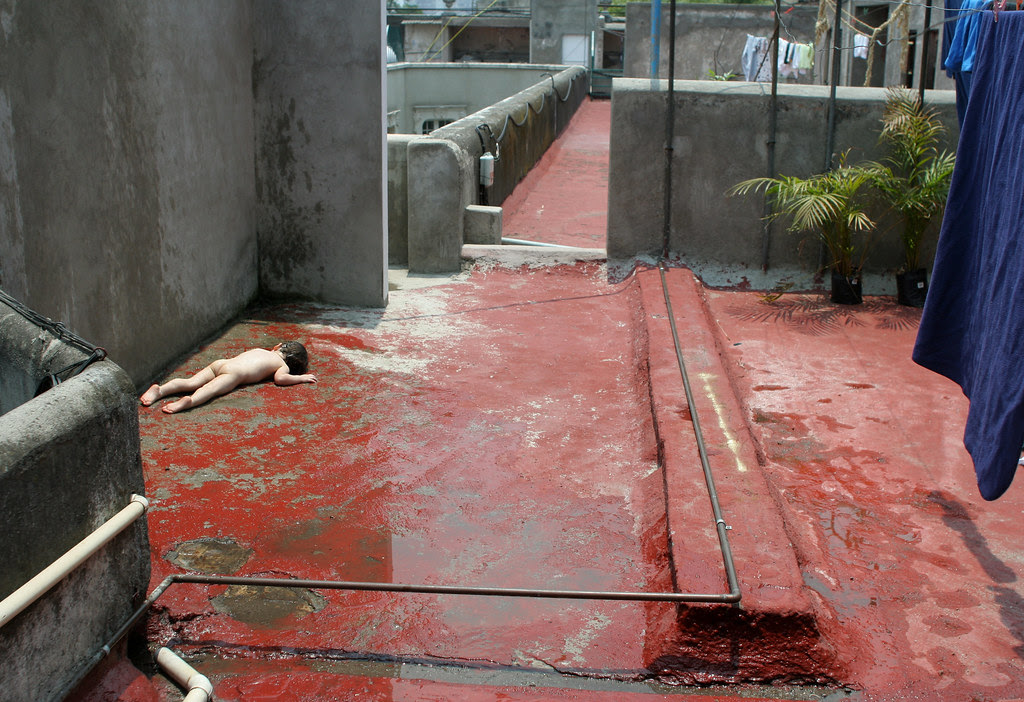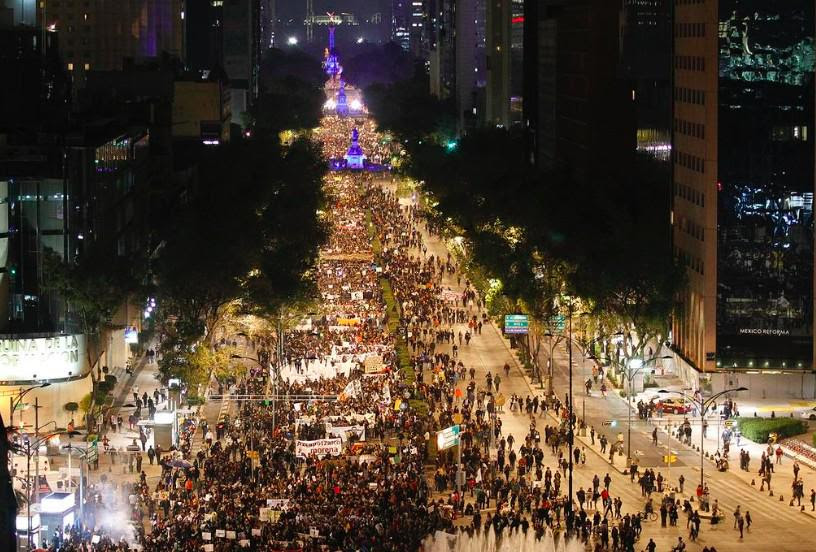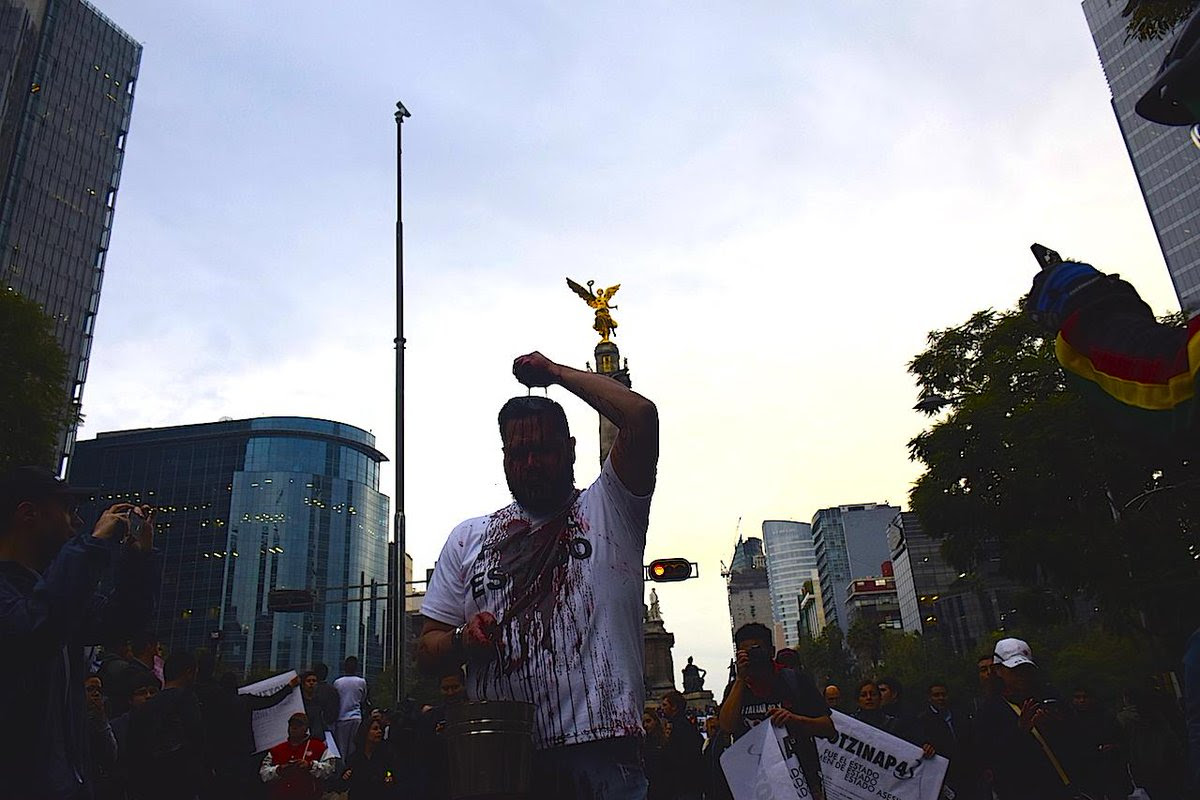"@JesusdeVeracruz: Calling the ancestors #SavingMexico #YaMeCansé @epigmenioibarra @reyes lourdes": image via Gerardo Oliver @gerardooliver, 21 November 2014
He could see hills on the horizon. The hills were dark yellow and
black. Past the hills, he guessed, was the desert. He felt the urge to
leave and drive into the hills, but when he got back to his table the
woman had brought him a beer and a very thick kind of sandwich. He took a
bite and it was good. The taste was strange, spicy. Out of curiosity,
he lifted the piece of bread on top: the sandwich was full of all kinds
of things. He took a long drink of beer and stretched in his chair.
Through the vine leaves he saw a bee, perched motionless. Two slender
rays of sun fell vertically on the dirt floor. When the man came back he
asked how to get to the hills. The man laughed. He spoke a few words
Fate didn’t understand and then he said not pretty, several times.
“Not pretty?”
“Not pretty,” said the man, and he laughed again.
Then he took Fate by the arm and dragged him into a room that served
as a kitchen and that looked very tidy to Fate, each thing in its place,
not a spot of grease on the white-tiled wall, and he pointed to the
garbage can.
“Hills not pretty?” asked Fate.
The man laughed again.
“Hills are garbage?”
The man couldn’t stop laughing. He had a bird tattoed on his left
forearm. Not a bird in flight, like most tattoos of birds, but a bird
perched on a branch, a little bird, possibly a swallow.
“Hills a garbage dump?”
The man laughed even more and nodded his head.
Roberto Bolaño (1953-2002): from Part Three: The Part About Fate, in 2666 (2004), English translation by Natasha Wimmer, 2008

Mexico City, Mexico. A costumed protester marches with thousands of others, to demand authorities find the 43 missing students: photo by Eduardo Verdugo / AP, 20 November 2014

Ciudad Juárez at dusk looking west toward Misión de Nuestra Señora de Guadalupe: photo by Daniel Schwen, 3 April 2004

Heavenly city (Tenochtitlan), Mexico: photo by Jair Cabrera Torres (rastamaniaco), 28 January 2014

Durango: photo by Jair Cabrera Torres (rastamaniaco), 4 May 2013

Octavio García. Octavio García "El Payo" toma un respiro y un descanso para bajar la adrenalina bajo los tablados de la plaza. Puede apreciarse la construcción de esta a base de palos, mecates y petates. A "El Payo" le ha costado trabajo matar a su toro y lo ha dejado exhausto. Villa de Álvarez, Colima, México: photo by Emigdio Salgado (Millo Salgado), 12 February 2012

Vuelta al ruedo de Diego Silveti. Diego Silveti recibe un obsequio del público mientras da la vuelta al ruedo por cortar una oreja. Villa de Álvarez, Colima, México: photo by Emigdio Salgado (Millo Salgado), 12 February 2012

Picador al caballo. Villa de Álvarez, Colima, México: photo by Emigdio Salgado (Millo Salgado), 14 February 2012

Hurricane, Acapulco, Guerrero: photo by Jair Cabrera Torres (rastamaniaco), 20 September 2013

Slide area, Cuajimalpa: photo by Jair Cabrera Torres (rastamaniaco), 26 September 2013

IMG_1963: photo by locaburg, 27 February 2014

IMG_5423 (iztapalapa): photo by locaburg, 17 March 2006

IMG_0190 (Julian, azotea, laundry): photo by locaburg, 6 May 2006

IMG_2002 (dog, Monte Escobedo, Zacatecas): photo by locaburg, 10 January 2008

IMG_1482 (dog, skull, Xoloscuintle, iztapalapa): photo by locaburg, 16 February 2011

IMG_7684 (dog, car, brick): photo by locaburg, 22 December 2009

Ceramic representation of Mictlantecuhtli, Aztec god of the dead and king of Mictlan (Chicunauhmictlan), lowest and northernmost section of the underworld, recovered during excavation of the House of Eagles in the Templo Mayor, now on display at the museum of the Templo Mayor, Mexico City: photo by Thelmadatter, 23 March 2008
¿Solo asi he de irme?
¿Como las flores que perecieron?
¿Nada quedara en mi nombre?
¿Nada de mi paso aqui en la tierra?
¡Al menos flores, al menos cantos!
Was it for this only that I came?
To die away like the flowers?
To die away like the flowers?
Nothing left of my name?
Nor of the days I have spent on earth?
At least my flowers, at least my songs!
from Cantos de Huexotzingo: Nahuatl, attributed to Ayocuan Cuetzpaltzin, aka Aguila Blanca de Tecamachalco (The White Eagle of Tecamachalco), early 16th c. (English: TC)

Statue of Mictlantecuhtli, Aztec god of the dead, museum of the Templo Mayor, Mexico City : photo by Jamie Dwyer, 19 August 2008
La imagen que muy seguramente no difundirán los medios. #EstadoFallido: image via Cesar Costa @EnriqueIX, 20 November 2014

Students clash with riot police near Mexico City’s international airport: photo by Alfredo Estrella / AFP, 20 November 2014

Protesters throw stones at
riot police. Global marches called for justice and a solution for the 43
missing student teachers and their families: photo by Anadolu Agency, 20 November 2014

Protesters burn a police car during the global protests: photo by Anadolu Agency, 20 November 2014
Agent provocateur MT @AreliMSS Soldiers with civilian clothes break peaceful demo... outraged #YaMeCanse #Mexico: image via Anonymous @C0d3fr0sty, 20 November 2014

(translated) MT soldiers disguised as "civilians" infiltrate among people to disturb and blame protesters #YaMeCanse: image via Anonymous @C0d3fr0sty, 20 November 2014
"if we burn, you burn with us" #YaMeCanse: image via y. @stilackles, 21 November 2014
The Mexican Revolution started November 20th 1910....It is obviously not finished... Viva La Revolucion! #Ayotzinapa: image via Viva la causa! 70@torinoman, 20 November 2014

Mexico City, Mexico Demonstrators gather to protest over widespread corruption and the missing students from the city of Iguala: photo by Zuma / Rex, 20 November 2014
RT @EnrigoJM: And media.. Stop talking about the disturbers. focus on the REAL PURPOSE #YaMCanse #Ayotzinapa: image via peperivera @peperivera, 20 November 2014

Thousands of students and civil organizations participate in a march, with banners reading ‘murderer’: photo by Jose Mendez / EPA, 20 November 2014
“Toda vida, le dijo esa noche Epifanio a Lalo Cura, por más feliz
que sea, acaba siempre en dolor y sufrimiento. Depende, dijo Lalo Cura.
¿Depende de qué, buey? De muchas cosas, dijo Lalo Cura. Si te pegan un
balazo en la nuca, por ejemplo, y el pinche asesino se acerca sin que lo
escuches, te vas al otro mundo sin dolor y sin sufrimiento. Pinche
escuincle, dijo Epifanio. ¿A ti han pegado muchos tiros en la nuca?”
“Todo pasaba por el filtro de las palabras, convenientemente adecuado a nuestro miedo. ¿Qué hace un niño cuando tiene miedo? Cierra los ojos. ¿Qué hace un niño al que van a violar y luego matar? Cierra los ojos. Y también grita, pero primero cierra los ojos. Las palabras servían para ese fin. Y es curioso, pues todos los arquetipos de la locura y la crueldad humana no han sido inventados por los hombres de esta época sino por nuestros antepasados. Los griegos inventaron, por decirlo de alguna manera, el mal, vieron el mal que todos llevamos dentro, pero los testimonios o las pruebas de ese mal ya no nos conmueven, nos parecen futiles, ininteligibles[...] Durante la Comuna de 1871 murieron asesinadas miles de personas y nadie derramó una lágrima por ellas. Por esa misma fecha un afilador de cuchillos mató a una mujer y a su anciana madre (no a la madre de la mujer, sino a su propia madre, querido amigo) y luego fue abatido por la policía. La noticia no sólo recorrió los periódicos de Francia sino que también fue reseñada en otros periódicos de Europa.”
Robert Bolaño: from 2666, 2004
“Todo pasaba por el filtro de las palabras, convenientemente adecuado a nuestro miedo. ¿Qué hace un niño cuando tiene miedo? Cierra los ojos. ¿Qué hace un niño al que van a violar y luego matar? Cierra los ojos. Y también grita, pero primero cierra los ojos. Las palabras servían para ese fin. Y es curioso, pues todos los arquetipos de la locura y la crueldad humana no han sido inventados por los hombres de esta época sino por nuestros antepasados. Los griegos inventaron, por decirlo de alguna manera, el mal, vieron el mal que todos llevamos dentro, pero los testimonios o las pruebas de ese mal ya no nos conmueven, nos parecen futiles, ininteligibles[...] Durante la Comuna de 1871 murieron asesinadas miles de personas y nadie derramó una lágrima por ellas. Por esa misma fecha un afilador de cuchillos mató a una mujer y a su anciana madre (no a la madre de la mujer, sino a su propia madre, querido amigo) y luego fue abatido por la policía. La noticia no sólo recorrió los periódicos de Francia sino que también fue reseñada en otros periódicos de Europa.”
Robert Bolaño: from 2666, 2004

Cruces colocadas en Lomas del Poleo Planta Alta (Ciudad Juárez, Chihuahua) en el lugar donde fueron encontrados 8 cuerpos de mujeres víctimas de feminicidio en 1996: photo by lose, 31 August 2007

IMG_8128: photo by locaburg, 9 November 2010
Aún puede quedar alguna duda? #FueElEstado y no diremos #YaMeCanse hasta que #SeVayanTodos #20NovMx: image via Penagos @epenagosv, 20 November 2014












5 comments:
Bolaño´s : the wonder of life can be among the bleak reality ...
wonderful poem in that mexican language...thanks!
Grim hope. All the flowers, all the songs, still gone. But at least the people erupt like a volcano.
“Every life, Epifanio said that night to Lalo Cura—even the happiest there could be, always ends in pain and suffering. That depends, said Lalo Cura. Depends on what, dude? On many things, said Lalo Cura. If someone puts a bullet in the back of your head, for example, and the chicken-shit killer approaches without you hearing him, you pass to the other world without pain or suffering. Lousy pissant, said Epifanio. And how many bullets have you taken to the back of the head?”
“Everything passes through the filter of words, conveniently adequate to our fears. What does the child do when he’s afraid? He closes his eyes. What does a child do who’s going to be raped and then killed? She closes her eyes. And she screams too, but first she closes her eyes. Words serve that same purpose. And it’s odd that all the archetypes of madness and human cruelty haven’t been invented by the humans of this epoch but by our ancestors. The Greeks, to put it one way, invented evil; they saw the evil that we all carry within ourselves; but the proofs, or the testaments to this evil no longer move us; they seem to us futile, unintelligible […] During the Commune of 1871, thousands of people were murdered, and no one shed a tear for them. Around that same time, a knife grinder killed his wife and elderly mother (not his wife’s mother, but his own mother, dear friend) and was later taken down by the police. The news not only made all the French newspapers, but was also written up in other papers in Europe.”
Robert Bolaño: from 2666, 2004 My translation.
Many thanks all.
Bleak for so long, yes, but finally, yes, erupting. At a certain point there's no more than a fine line between hope and desperation, and from there things can go either way. The back door palace arrangement with death which comprises what passes for government in Mexico, an arrangement made possible by, helped along and more or less officially formalized by the massive profit taking system that moves the drugs across the border into the consumption cycle (with the US as willing accomplice and convenient accessory), is probably well beyond dismantling as long as the Imperio del Norte remains in place. And that's a Thousand Year, billion fear, trillion tear Plan, with built in accommodation for re-upping and extension as long as there's still a drop of blood to be wrung or a peso or penny to be turned by anybody in this gruesome picture.
That one bit of 2666 I left untranslated because sometimes it's interesting to come up with our own versions. Particularly when there's a professional in the house (thank you, Hazen).
Brilliant bit of commentary, Tom.
I want to have hope for Mexico but it's hard.
Post a Comment